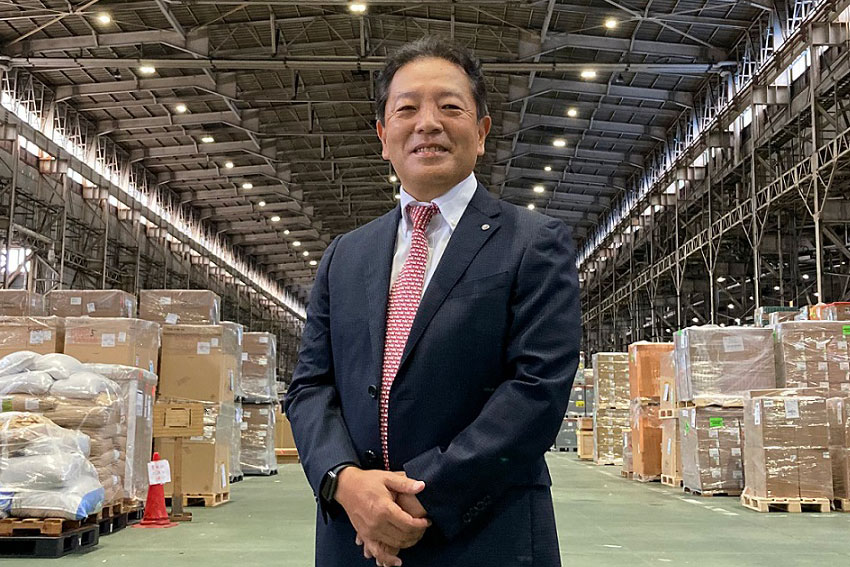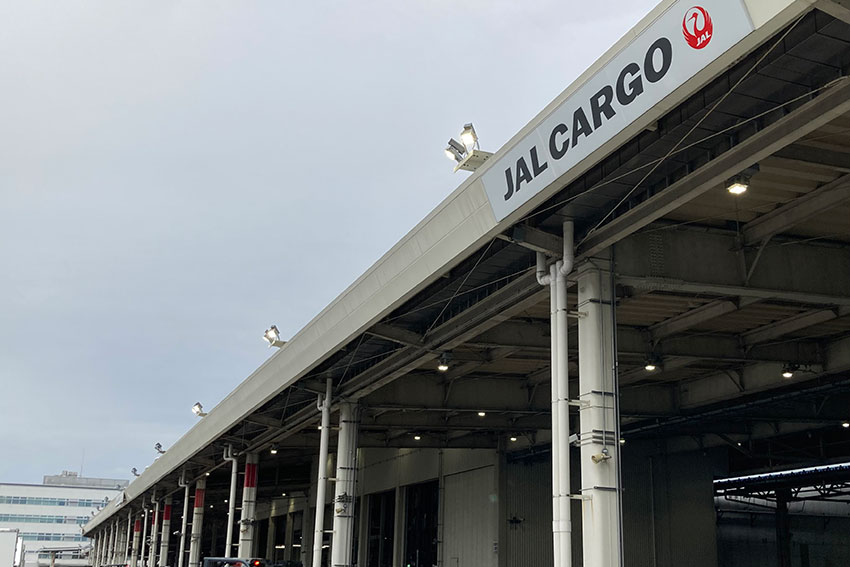We sat down with Mr. Morimoto of JAL cargo to discuss the impact of the Covid-19 pandemic on the air cargo sector, and the direction of their midterm strategy.

Can you elaborate for us both the impact recent global logistics disruptions such as the Shanghai lockdown have had on JAL Cargo’s activities, and your continuity plan to mitigate the impact of similar disruptions that could happen again in the future?
First of all, the impact of Covid-19 was huge. It started in China in December 2019. Around March of 2020, our volume of cargo actually went up, due to the demand for masks and medical supplies. However, after that, from April to July 2020, there was a sharp decrease in the volume of cargo. The drop was around 30% from the previous year, and therefore, the volume of cargo was around 70% of the previous year’s volume. Of course, tourist numbers also dropped significantly in this period. There were also sharp decreases in manufacturing, and this had a huge impact for us. However, in September 2020, the cargo volume suddenly jumped back up again, and this was significant for us. The reason for this was that manufacturing in China recovered, and we saw a huge demand for the transport of cargo again.
Before Covid-19, the logistics sector was not in great shape. Shipping companies were not making marine containers, so the sudden increase in demand had a huge impact. The huge demand caused a supply problem due to this shortage of marine containers. Another issue was, that especially in the US, many of the logistic workers at the ports were infected with Covid-19, which led to a labor shortage as well.
While the volume of cargo increased, on the other hand, the number of tourists did not increase, so there was significantly less space in the belly of passenger planes due to suspension of the passenger flights. Before Covid, cargo was distributed to Narita, Haneda, Nagoya, Kansai and Fukuoka airports and so on. However, due to a shortage in supply in passenger flights, considerable volume of the international cargo concentrated to Narita, which is a base for international air cargo. It had a big impact. At the same time, it was a tailwind for us, as we are very busy.
The volume of cargo in maritime shipping is much larger than air cargo, so we cannot cover the entire volume by air cargo alone. However, some cargo that was normally transported via maritime routes is now being transported by air. We have been busy for the last two years due to Covid-19, and our finances have improved.
The international cargo volume in Narita in March 2020 jumped up due to the demand for masks and medical supplies. It then dropped between April and July. The cargo volume then recovered strongly. Our company’s share of the international cargo traffic in Narita is about 33%.
The impact of the Ukrainian situation is also significant. When the Russian invasion of Ukraine began in late February and early March, the flights to and from Europe stopped. One of our customer airlines which is based in Russia stopped its operation and trade. This situation with the airline continued for two months, from the end of March. However, from May, the airline’s traffic was replaced by Middle Eastern air companies as well as Asian air companies. Since June, there has been a full recovery by them.
At the end of March, there was also a lockdown in Shanghai. As a result, maritime shipping stopped almost entirely. This led to an increase in air cargo. When maritime shipping stops, the impact on air cargo is huge. Medical supplies, food, and other daily supplies have to be shifted to air cargo. Rather than raising our fares or prices, there was an increased demand from the users to have their goods carried by air cargo, even if the prices were high. This has been very positive for us.
What would that ideal balance look like?
I think that now things have stabilized, there is already a good balance. In terms of price, the situation is currently good for us, as the customers are now aware that air cargo is very important.
Covid has shown the world that our supply chains are very reliant on China, and that when there is a problem in China, the rest of the world is affected. When we interviewed the president of Mitsui O.S.K., he told us that this may represent an opportunity for Japanese shipping firms to take traffic away from China. Do you believe that this is an opportunity for Japan to take some of the cargo away from China?
Yes, I agree with this sentiment. When you think about what is special about JAL Cargo, the large volume of air cargo presents an opportunity for us, if we have the flight routes where large demand exists. However, what we are looking at now is added value shipping. We focus on the things we carry rather than the location. Production bases have been shifting away from China to Vietnam and other Southeast Asian countries. The air cargo demand will increase in such countries, so there is a chance for us.
We have a large network of passenger flights, especially in Southeast Asia and East Asia. That is one of our major strengths. The cargo from Southeast Asia and China is coming on different routes. It is possible for us to gather some of that cargo from the Asian countries, and then ship it to the large cities in North America. It will help us to develop our function here in Japan. Japan can act as a gateway between Southeast Asia and North America.
That kind of shipment existed before Covid. For example, cargo was shipped from Shanghai and Beijing to the big cities in North America. However, Japan was bypassed. If the cargo is separated, Japan could certainly become the gateway for these shipments.
It is an interesting distinction that you make, with it being less about the where, and more about the what, in terms of adding value to what you bring as the freight operator. A great example of this has been pharmaceuticals. As you are looking to add value, are there any other sectors besides pharmaceuticals that you see as a core market, or that you anticipate the greatest demand for?
Another focus is perishable foods produced in Japan, especially those produced in different regions of Japan such as Hokkaido, Kyushu and Okinawa. The Ministry of Agriculture and Forestry is aiming to increase the export of Japanese food from JPY 1 trillion to JPY 5 trillion by 2025. We are looking at this market.
I would like to ask you about your J Solutions Pharma business. In 2021 in Europe, there was a very big scandal in France relating to the Pfizer vaccine that was delivered to France from the UK. The vaccine was unusable, because the temperature had fluctuated too much. This was because as it was unloaded from the plane into the trains, they could not maintain an average temperature. The big problem is that there are choke points when it comes to transportation between different modes of cargo, and there can be big fluctuations in temperature. How does J Solutions Pharma ensure that you are able to maintain a stable temperature throughout the operations?
The dedicated containers for the pharmaceutical products belong to the pharmaceutical companies. However, there are some air containers for carrying those dedicated containers in. We do research with pharmaceutical companies to develop secure containers for the transport of their products. A new exclusive refrigerating facility for pharmaceutical products is now under construction which will be completed by the end of September. In that facility, we can control the temperature range from -20 degrees Celsius to 15 degrees Celsius. This range will be increased in the future. We do our packing of the cargo within this facility to ensure the temperature of sensitive products.
How feasible or realistic is carbon neutrality by 2050 for this sector?
Japan Airlines has declared it will realize carbon neutrality by 2050. For JAL Group companies, upgrading to fuel-efficient aircraft such as Airbus A350 and Boeing 787, or optimizing flight plans to try to minimize fuel consumption in which we are working towards that target. JAL and ANA are now jointly trying to develop sustainable air fuel. The industry as a whole is working together, so that we can achieve carbon neutrality by 2050.
We are also doing the groundwork to reduce CO2 emissions in our operations. For example, we are going to replace forklifts and other ground vehicles with EVs. We are also reducing the amount of wooden timber and beam that we use as stabilizers for the cargo. We are working on reducing the amount of paper that we use as well.
How do you think that digitalization will transform your business ten years from now? Can you tell us about your own digital initiatives in the company?
In ten years, I think that things will have moved much faster than we can predict now. When I returned home after an overseas assignment in Shanghai four years ago, I found that the air cargo sector was one of the slowest sectors when it comes to digital transformation. For example, a lot of paper was still being used. That being said, in the past year or two, things have been changing rapidly. Ten years from now, I think that paper documents will disappear, and information will be transmitted by digital means. People who use paper a lot feel uneasy when they don’t have paper documents, so even if they have the data on the computer, they still print it out. There are many people like this, however, ten years from now, that generation may disappear and things will certainly change.
When you mentioned sustainability, you spoke about more efficient air routes as being a strategy. You can make use of a massive global network, with numerous locations across North America, Asia, Europe and Oceania. Are there any new key markets that you are considering expanding into, for example Africa or South America, in terms of developing your international business?
For now, I do not think there is any market we’d like to expand into. Perhaps there could be in the future. When it comes to semiconductor manufacturing, there is an airport close to one of the manufacturing plants, so they don’t use regular flights, but rather chartered flights instead, for carrying their cargo. This way of moving cargo could be one thing that we look at in the future.
For example, in Ireland there is large-scale semiconductor plant, and we carry their cargo. The existing JAL has regular flights up to London, and then different carriers have been operating. Now, however, if we had direct flights to Shannon, in Ireland, so maybe we could cooperate directly with the manufacturer there.
Imagine that we come back to have an interview again on the last day of your presidency. What objectives and ambitions would you like to have achieved during your time as president?
I have been president for four years now, and we have around 800 employees of our own company group and around 600 employees of our partner companies working together. I want to explore new business opportunities with my co-workers. I want our company to be open to change, and I want to ensure that my co-workers are happy and excited. That is what I want for the future.

JAL Cargo Building (at Narita International Airport)
0 COMMENTS